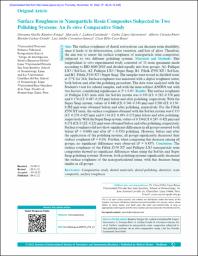Mostrar el registro sencillo del ítem
Surface Roughness in Nanoparticle Resin Composites Subjected to Two Polishing Systems: An In vitro Comparative Study
| dc.contributor.author | Cayo Rojas, César Félix | |
| dc.contributor.author | Ramírez-Vargas, Giovanna Gisella | |
| dc.contributor.author | Ladera-Castañeda, Marysela I. | |
| dc.contributor.author | López-Gurreonero, Carlos | |
| dc.contributor.author | Cornejo-Pinto, Alberto | |
| dc.contributor.author | Cachay-Criado, Hernán | |
| dc.contributor.author | Cervantes-Ganoza, Luis Adolfo | |
| dc.date.accessioned | 2022-11-28T20:14:23Z | |
| dc.date.available | 2022-11-28T20:14:23Z | |
| dc.date.issued | 2022-11-11 | |
| dc.identifier.uri | https://hdl.handle.net/20.500.14308/4235 | |
| dc.description.abstract | Aim: The surface roughness of dental restorations can decrease resin durability, since it leads to its deterioration, color variation, and loss of gloss. Therefore, the aim was to assess the surface roughness of nanoparticle resin composites, subjected to two different polishing systems. Materials and Methods: This longitudinal in vitro experimental study consisted of 32 resin specimens made according to ISO 4049-2019 and divided equally into four groups: A1: Palfique LX5 / Sof-Lex, A2: Palfique LX5 / Super Snap, B1: Filtek Z350 XT / Sof-Lex, and B2: Filtek Z350 XT / Super Snap. The samples were stored in distilled water at 37°C for 24h. Surface roughness was measured with a digital roughness tester, both before and after the polishing procedure. The data were analyzed with the Student’s t-test for related samples, and with the inter-subject ANOVA test with two factors; considering significance at P < 0.05. Results: The surface roughness of Palfique LX5 resin with the Sof-lex system was 0.330 (CI: 0.282–0.378 µm) and 0.170 (CI: 0.087–0.253 µm) before and after polishing, respectively. With the Super Snap system, values of 0.448 (CI: 0.346–0.549 µm) and 0.206 (CI: 0.130– 0.282 µm) were obtained before and after polishing, respectively. For the Filtek Z350 XT resin, the surface roughness obtained with the Sof-lex system was 0.353 (CI: 0.278–0.427 µm) and 0.134 (CI: 0.095–0.172 µm) before and after polishing, respectively. With the Super Snap system, values of 0.334 (CI: 0.247–0.421 µm) and 0.171 (CI: 0.122–0.221 µm) were obtained before and after polishing, respectively. Surface roughness did not show significant differences in all groups assessed both before (P = 0.068) and after (P = 0.335) polishing. However, before and after the application of the polishing systems, all groups significantly decreased their surface roughness (P < 0.05). Further, when comparing this decrease among all groups, no significant differences were observed (P = 0.437). Conclusion: The surface roughness of the Filtek Z350 XT and Palfique LX5 nanoparticle resin composites showed no significant differences when using the Sof-lex and Super Snap polishing systems. However, both polishing systems significantly decreased the surface roughness of the nanoparticulated resins, with this decrease being similar in all groups. | es_PE |
| dc.description.uri | Trabajo de investigacion | es_PE |
| dc.format | application/pdf | es_PE |
| dc.language.iso | en | es_PE |
| dc.publisher | Journal of International Society of Preventive and Communitary Dentistry | es_PE |
| dc.rights | info:eu-repo/semantics/openAccess | es_PE |
| dc.rights | Attribution-NonCommercial-NoDerivs 3.0 United States | * |
| dc.rights.uri | http://creativecommons.org/licenses/by-nc-nd/3.0/us/ | * |
| dc.source | Universidad Privada San Juan Bautista | es_PE |
| dc.source | Repositorio institucional - UPSJB | es_PE |
| dc.subject | Estudio comparativo | es_PE |
| dc.subject | Materiales dentales | es_PE |
| dc.subject | Pulido dental | es_PE |
| dc.subject | Odontología | es_PE |
| dc.subject | Resina | es_PE |
| dc.subject | Compuesto | es_PE |
| dc.subject | Rugosidad de la superficie | es_PE |
| dc.title | Surface Roughness in Nanoparticle Resin Composites Subjected to Two Polishing Systems: An In vitro Comparative Study | es_PE |
| dc.type | info:eu-repo/semantics/article | es_PE |
| dc.subject.ocde | https://purl.org/pe-repo/ocde/ford#3.02.14 | es_PE |
| dc.publisher.country | IN | es_PE |
| dc.date.embargoEnd | 2022-11-29 | |
| dc.type.version | info:eu-repo/semantics/publishedVersion | es_PE |
| upsjb.especialidad | Estomatología | es_PE |
| upsjb.sede | Chorrillos | es_PE |



